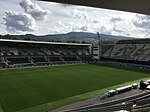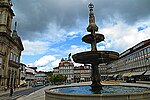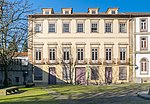Estádio D. Afonso Henriques (1965)
Defunct football venues in PortugalPortuguese sports venue stubsSports venues completed in 1965
Estádio D. Afonso Henriques was a multi-use stadium in Guimarães, Portugal. It was initially used as the stadium of Vitória S.C. matches. It was replaced by the current Estádio D. Afonso Henriques in 2004. The capacity of the stadium was 33,000 spectators.
Excerpt from the Wikipedia article Estádio D. Afonso Henriques (1965) (License: CC BY-SA 3.0, Authors).Estádio D. Afonso Henriques (1965)
Rua Doutor José Pinto Rodrigues, Guimarães
Geographical coordinates (GPS) Address Nearby Places Show on map
Geographical coordinates (GPS)
| Latitude | Longitude |
|---|---|
| N 41.445833333333 ° | E -8.3011111111111 ° |
Address
Estádio Dom Afonso Henriques
Rua Doutor José Pinto Rodrigues
4810-420 Guimarães (Oliveira, São Paio e São Sebastião)
Portugal
Open on Google Maps











